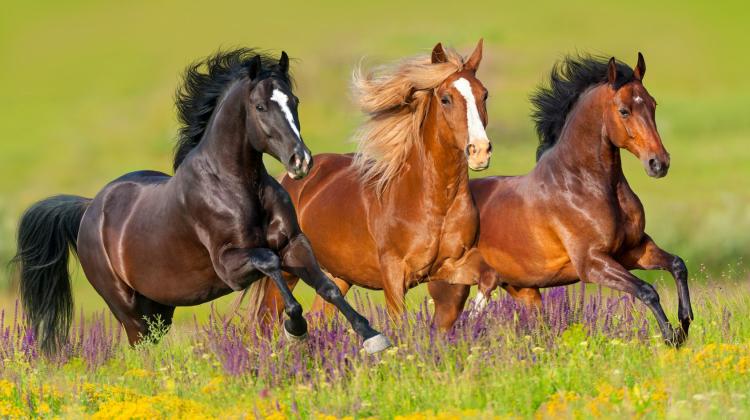Toruń/ Innovative research on horses in the Middle Ages - at the Nicolaus Copernicus University
 Photo: Fotolia
Photo: Fotolia
Horses have accompanied people for thousands of years. What role did they play in the life of early medieval society in Polish territories? How long did they serve, how were they cared for, and why were some of them eaten, and others - carefully buried? Study on the presence and use of horses in medieval Poland has begun in Toruń.
"The significance of animals in the Middle Ages - as well as human history - was most often studied on the basis of historical records - chronicles, travel accounts, registers - or iconographic representations. But archaeology offers a different cognitive source. In the case of animals, including horses, these are bones and teeth of animals used by man" - told PAP archaeologist and engineer zootechnician, Dr. Daniel Makowiecki from the Nicolaus Copernicus University in Toruń.
"Our goal is to show the importance of horses in early Piast and district Poland. The starting point for our research are the remains of this mammal found during excavations" - he said.
His research group has received a grant from the National Science Centre for this project.
The scientist emphasised that just as it is today - also in the studied period, horse was an elite species in the social sense and meant prestige for its owners.
He also remarked that there were still many unknowns regarding the exact appearance of horses during this period: their form (race), size or colour. We do not exactly know how they were used by man? How they were cared for? And why some horses were eaten, and others - carefully buried, sometimes with the owner?
"To consider these problems at the beginning of the Polish state, information can only be taken from archaeology, or more precisely - from archaeozoology. We have a general view of the role of the horse in those times, but this knowledge is still fragmented and scattered. Horses have not been a priority in historical studies. There are only short references to them in monographs devoted to all animals. The remains (of horses - PAP) have been found and are being found in all places where settlements and settlements were once located. They are also found - which is not common known - in sacral, ritual and sacrificial places. We also find graves of horses. They are not common in the Slavic lands, but recently more and more of them are being discovered, including ones in lakes surrounding islands and on the islands themselves - said the scientist.
Researchers find horse skulls near ancient buildings and defence embankments (foundation offerings), as well as in bony materials that are waste from consumed meat of such animals as cattle, pigs, sheep or goats.
"In excavation materials, horse remains always constitute the smallest percentage in the group of household animals. If we find their graves - these are the grounds to believe that these animals have been appreciated - buried, not eaten. I\'ve found this species particularly interesting because there questions that I still have not found an answer to because of the +mediocre+ state of research "- said Prof. Makowiecki.
Speaking about the context of his research, the scientist emphasised the significance of the period, which it concerns - the times of feudal fragmentation. "These were the beginnings of the formation of the Polish statehood. One of the most important factors enabling its formation were the armed forces. Horses were an important part of their equipment. I am interested in what kind of horse it was: how it looked, where it came from, why Various populations were kept in various parts of Slavic lands and in the Piast Poland" - added Prof. Makowiecki.
The scientist added that he had a lot of research material and some knowledge allowing to formulate specific research problems. One of the most important preliminary hypotheses is the well-documented diversity of horse sizes in Poland, depending on the region.
"Horses in core, Mieszko\'s Poland were of a different size than in Chełmno land, Gdańsk and Western Pomerania, Lower Silesia or Prussia. Now we need to determine what colour they were, where they came from and why. On Ostrów Lednicki - the cradle of Polish statehood - we have two groups of horses. The smaller ones were more suited to be transport animals, and larger ones for horsemen. The early medieval horses were very small either way, and in this period there were also very small wild horses (in Prussia and Pomerania). New research techniques allow us to look for the source of this diversity. We do not see similar body size variations in other species during this period - those populations are very homogeneous in this respect" - added Prof. Makowiecki.
Such a state of affairs could indicate that horses came to the medieval Poland from very different parts of Europe, and perhaps also Asia.
"I would prefer not to finish the history of horse with this grant. This project is the first in the world to capture such topics spatially and temporally, using the latest technological achievements of science, including molecular biology - DNA or isotopic research" - said the scientist. (PAP)
author: Tomasz Więcławski
editor: Anna Ślązak
twi/ zan kap//
tr. RL
Przed dodaniem komentarza prosimy o zapoznanie z Regulaminem forum serwisu Nauka w Polsce.















